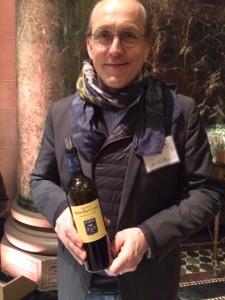By Christopher Matthews
The temperature outside the annual Union des Grands Crus de Bordeaux (UGCB) tasting held at Cipriani 42nd Street in Manhattan on 21 January was in single digits, but the reception by the industry throng inside the cavernous space for Bordeaux’s 2016 vintage was warm, bordering on chaud.

Grand Crus de Bordeaux tasting, Manhattan-style
Deservedly so.
Many Bordelaise vintners have called 2016 a “miracle vintage”, one that started out as a rainy washout in the first half, but then finished almost completely dry and sunny throughout July, August and September (save for a much-needed rain storm on 13 September), with warm (not hot) days and cool nights. The overall result, especially for the reds: elegant, phenolically ripe wines brimming with gorgeous red-ish fruit, silky tannins, great energy and freshness. While these wines will age well in the cellar, they offer pleasure in relative youth as well, the best of both worlds. And based on the sterling quality of the Grand Crus, 2016 should be an excellent vintage for less expensive, ready-to-drink appellations in Bordeaux (e.g. AOC Bordeaux, Cotes de Bordeaux, etc.) in the $12-$20 range.
After a string of four stellar vintages, the Grand Cru whites of Pessac-Léognan and Graves shone a little less brightly than the reds in 2016. In a sense, the whites, especially their Sauvignon Blanc (SB) components, had too much of a good thing – sun – making for a very ripe grapes, but with somewhat less acidity and verve than in recent vintages. That said, I sampled some impressive ones.

My top white
At the top of my list was Domaine de Chevalier, featuring a fresh orchard fruit/green apple nose, and a juicy, energetic palate of pomelo, grapefruit and attractive minerality. The dependable Chateau Carbonnieux also showed well, sporting a classic SB nose of gooseberry and grapefruit and a juicy, a bone dry and mineral palate, finishing clean and citric. Chateau Olivier had a clean, citrusy nose with fresh Gala apple and grapefruit on the palate. And on the richer side of the ledger, Chateau Smith Haut Lafite hit yet another home run: a heady, floral nose of tropical fruit and slight spice on a big, but balanced frame of tropical fruit with a creamy, long finish. And Chateau Pape Clément showed how to use new oak judiciously in its pretty, balanced and pineapple-infused beauty.
…and impressions in red
Even in stellar vintages, it is often possible to pinpoint which districts really stood out. Not so in 2016, where the sunny, dry tide seemingly lifted all boats. In other words, this is a terroir vintage, one that really plays back the microclimate, soils and grape varieties of the individual châteaux. Because it was an exceedingly dry growing season, for example, those properties that have a higher proportion of clay soils, which is best for water retention, have generally performed well, according to industry reports. And Merlot, the dominant grape of the Bordeaux region (though not in the Medoc), which does best in clay soils, actually yielded in some cases higher alcohol levels in 2016 than its normally more powerful partner (and later ripening) Cabernet Sauvignon, said Chateau Kirwan’s Sophie Schyler-Thierry. When asked to compare 2016 with the similarly esteemed 2015 vintage, Chateau Beychevelle’s Philippe Blanc made this distinction: “In 2015, the wines had more cooked fruit, in 2016, it has more fresh fruit.” This freshness is the hallmark of the vintage.

Philippe Blanc of the estimable Chateau Beychevelle
The vastness of the UGCB tasting precludes sampling every chateau (at least for me!). I have my benchmarks in the various districts, along with chateaux I’ve followed over the years, a few random selections and some of the houses that generate buzz in the room. Based on this impressionistic-yet-consistent annual approach, the following are my highlights of the Grand Cru reds in 2016.
Full disclosure: I am a big fan of Pauillac. In 2016, however, I found that the Pauillacs (in general) were quite dense, and need more time to come together, compared with some other communes. That said, my “Best in Show” was a indeed a Pauillac: Chateau Pichon Baron , a complex, deeply layered wine with aromas of roasted coffee and Cassis, beautiful structure and balance, deep black berry fruit and a clean, minty and mineral finish. Simply a knockout.

Best in Show
Other favorites:
Château Grand-Puy-Lacoste (Pauillac) – earthy, Cassis nose, excellent structure, pretty black fruit (for the cellar).
Château Pichon Longueville Comtesse de Lalande (Pauillac) – floral nose, wild berry and Cassis flavors with freshness, depth and chewy tannins (for the cellar).
Château de Pez (Saint-Estephe)
Château Leoville Barton (Saint-Julien)
Château Lagrange (Saint-Julien)
Château Beychevelle (Saint-Julien)
Château Gruaud Larose (Saint-Julien)
Château Prieuré-Lichine (Margaux) – a pretty, focused red-fruit nose, and a juicy, energetic and plummy palate with elegant structure and finesse.

Château Kirwan (Margaux)
Château Brane-Cantenac (Margaux)
Château Dauzac (Margaux)
Château Du Terte (Margaux)
Château Cantenac Brown (Margaux)
Château Cantemerle (Haut Medoc)
Château Gazin (Pomerol)
Château Valandraud (Saint-Émilion)
Château Canon La Gaffelière (Saint-Émilion) – superb yet again, with high-tone herbal aromas, beautiful briar fruit and compelling structure and finish.
Château Beau-Séjour Bécot (Saint-Émilion)
Chateau Smith Haut Lafite (Pessac-Léognan)

Smith Haut Lafite’s Fabien Teitgen aced both white and red in 2016
Château Latour-Martillac (Pessac-Léognan)
Domaine de Chevalier (Pessac-Léognan)
Santé!

